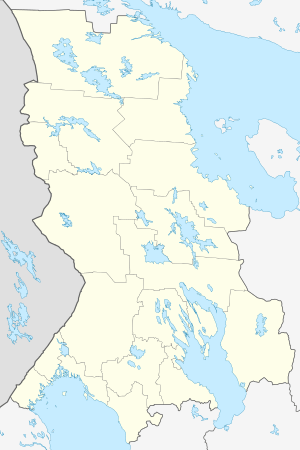Paanajärvi
| Paanajärvi (English) Панозеро, Panozero (Russian) Paanajärvi (Finnish) | |
|---|---|
|
- Rural locality - Settlement | |
|
| |
.svg.png) Location of the Republic of Karelia in Russia | |
 Paanajärvi | |
|
| |
| Administrative status | |
| Country | Russia |
| Federal subject | Republic of Karelia |
| Administrative district | Kemsky District |
| Statistics | |
| Time zone | MSK (UTC+03:00)[1] |
Paanajärvi (Russian: Панозеро, Panozero) is a rural locality (a settlement) in Kemsky District of the Republic of Karelia, located along the Kem River. Nowadays Paanajärvi belongs to the Vääräkoski municipality. Paanajärvi is also called Vanha Paanajärvi (The old Paanajärvi) to make a difference to the new settlement of Paanajärvi which is located 1.5 kilometers further away. The population of the village was approximately 100 in the year 2000.
Paanajärvi has preserved its old Karelian village outlook and is regarded as an important and endangered representative of the old style villages of Karelia. The plans to build the Valkiala hydroelectric power plant would destroy the village under a huge water reservoir. The proposed hydroelectric plant would not inundate Uusi Paanajärvi, but the settlement would become an island. Paanajärvi is one of the most valuable old style villages in Karelia and the only one remaining along the Kem river.
In the year 1996 Paanajärvi was selected to the World Monuments Watch (WMW) list of 100 most endangered sites. Paanajärvi village was also on the list from 1998-1999 and 2000-2001, after which the threat was considered to have passed. Due to its endangered status the village has received restoration funds from the Samuel Henry Kress foundation.
History
The village of Paanajärvi was inhabited in prehistoric times. In 1886 J.W. Juvelius brought some Stone Age objects found in the village to the collections in the Finnish National Museum in Helsinki.
According to some historical sources the coast of the White sea was occupied by Karelians as early as the ninth century A. D. Before that time the area was inhabited by Sami (Lapps).
According to tradition, Paanajärvi was the oldest village in eastern Karelia and its habitants spread from there to Jyskyjärvi and Suopassalmi villages. Paanajärvi was also the site of the first Christian church built in Viena district, and it was the administrative center of East Viena for centuries.
In 1879, Paanajärvi had 64 houses. In 1905, according to the official census, it had 73 houses and 427 inhabitants. At that time, the Paanajärvi district included eight other villages, yielding a total population of 1,029 people.
When the Usma Rapids, the largest on the Kemijoki River, were harnessed and the village of Usmana inundated, Paanajärvi became the only remaining Karelian village along the river. [2][3][4]
Footnotes
- ↑ Правительство Российской Федерации. Федеральный закон №107-ФЗ от 3 июня 2011 г. «Об исчислении времени», в ред. Федерального закона №271-ФЗ от 03 июля 2016 г. «О внесении изменений в Федеральный закон "Об исчислении времени"». Вступил в силу по истечении шестидесяти дней после дня официального опубликования (6 августа 2011 г.). Опубликован: "Российская газета", №120, 6 июня 2011 г. (Government of the Russian Federation. Federal Law #107-FZ of June 31, 2011 On Calculating Time, as amended by the Federal Law #271-FZ of July 03, 2016 On Amending Federal Law "On Calculating Time". Effective as of after sixty days following the day of the official publication.).
- ↑ http://www.juminkeko.fi/viena/en/paanajarvi.html
- ↑ http://www.wmf.org/project/paanaj%C3%A4rvi-village
- ↑ http://www2.hs.fi/english/archive/news.asp?id=20031104IE1